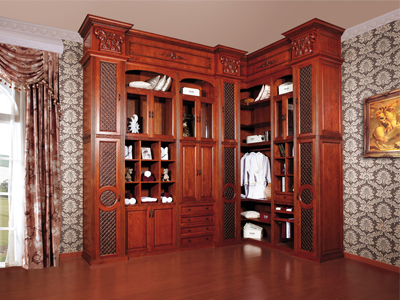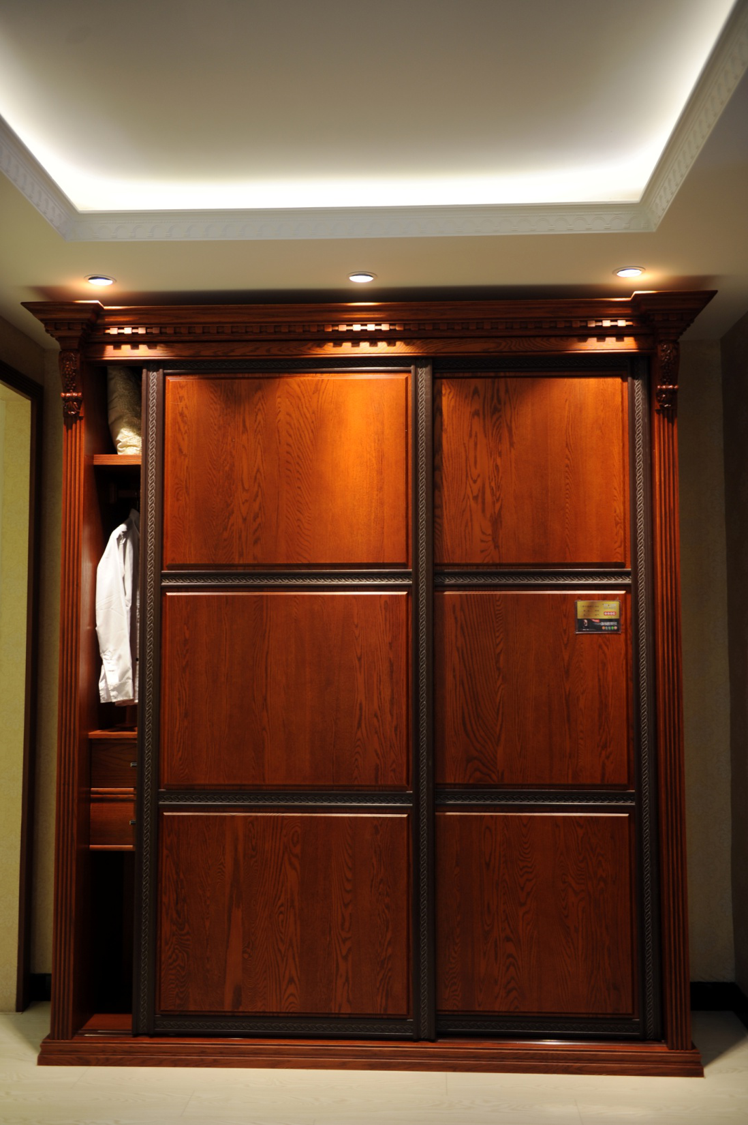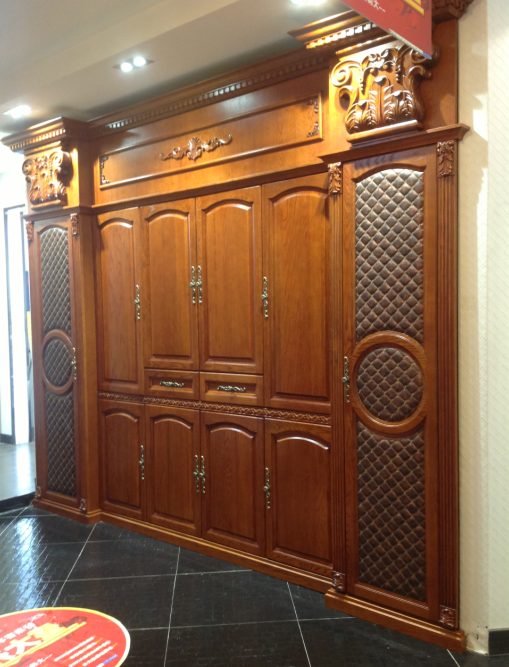Wooden door basic knowledge review old knowledge new

1. Terms and definitions of wooden door industry
1. Timber Door
Wooden doors and their frame products made of wooden materials (plates, sawn wood, composite wood, etc.) as the main material。
2. Sawn Lumber
A square or plank sawn from a log, commonly used to make solid wood furniture and veneer wood。
3. Veneer
From sawn timber with different ways of cutting, generally 0.6mm、0.2mm。Low grade wooden doors generally use 0.2mm。
4. coating
It is commonly known as paint, which is divided into water soluble and agent soluble。Water soluble is usually referred to as water-based paint, and agent soluble paint is commonly known as paint。
Second, wood door surface process (paint) classification
1. water coating
Water-based paint is the use of water diluent, does not contain organic solvent wood coated jewelry,Free of benzene, toluene, xylene, formaldehyde, free TDI toxic heavy metals and so on,Non-toxic and non-irritating odor,Harmless to human body,Do not pollute the environment,The paint film is full, crystal clear, good flexibility and has the characteristics of water resistance, wear resistance, aging resistance, yellowing resistance, fast drying, easy to use and so on。
2, paint 60/m2
The general varieties are PU polyurethane, PE unsaturated resin, NC nitro paint, UV UV curing paint and so on,Polyurethane paint is currently widely used in interior decoration,One of the most used varieties of paint, Its film is tough, strong adhesion, wear resistance, water resistance, chemical corrosion resistance, light preservation, color preservation and other excellent film properties
3, open paint/closed paint 40/m2
Paint finish effect。The former can see the wood texture and pores, the latter cannot。There are completely closed, semi-closed and other differences。
4, color paint/clear paint
Classify the paint according to whether it has color or not。The former is a finish that can cover the original base.There are many color choices, and the requirements for base materials are not very high。The latter is a transparent paint effect, you can see the color and pattern of the painted surface。Water paint is very demanding for woodworking, and the materials selected are very particular。
5, matt paint/gloss paint
The gloss of the coating can be divided into the following types: super matte, matte, eggshell light (soft), mercerization (satin), semi-gloss (semi-matte), high-gloss (bright)。Its gloss from low to high, the division is determined according to the degree of reflection of light。In the oil paint (paint), there are three kinds of matte, semi-matte and high-gloss, and the three kinds of gloss are not graded, but are used in different places, such as doors and Windows and furniture, multi-matte or semi-matte, and the floor generally uses high-gloss, because the general hardness of high gloss is correspondingly high。 In water-based paints (latex paints), almost all gloss is present。
3. Components, internal structure and classification of wooden doors
1.The name of each part of the wooden door。
Wooden doors are generally composed of a head, a door riser and a door core plate。There are also more detailed distinctions based on the position of the upper, lower, left and right。Taking the emergence as an example, it is divided into upper, middle, lock and lower, etc。But now designers because of design needs, many doors have broken the original structural parts, so they can not say everything。See the diagram below for details。
Name of each part of the door
Name of each part of the door cover
2. Internal structure of wooden door
In general, the structure of the solid wood composite door refers to the structure of the door support。At present, there are mainly the following structures:
LVL/ Wood finger joint + (MDF+ veneer)/plate
Particleboard + veneer
Honeycomb paper +MDF+ veneer/plywood
3. Classification of wooden doors
(1) Classified by opening mode。
Wooden doors can be divided into four types according to the opening method: flat door (also called sliding door) (P), sliding door (T), folding door (Z) and spring door (H)。Among them, when the fixed part is combined with a flat door or sliding door, it is a flat door or sliding door。
(2) Classified by internal structure。
According to the different structure of wooden doors, wooden doors can be divided into full solid wood doors, solid wood composite doors, and cleat molded hollow doors。
a) solid door:
The external material and internal material are completely unified wooden door。Generally refers to all kinds of wooden doors with this characteristic, including half glass doors and glass doors made of solid wood。Wood drying is the key process of solid wood door production。
b) laminate door
It refers to a variety of solid doors made of wood, wood-based panels, meager wood veneer and other materials, and generally refers to all wooden doors with the characteristics of this material。In the increasingly scarce forest resources, the contradiction between supply and demand of precious tree species is increasingly prominent, it is an effective means of comprehensive utilization of wood。The use of veneer technology is the most prominent feature of composite doors。
c) mold door
Plywood, wood as the skeleton material, the surface layer for wood-based panels or PVC panels pressed glued or molded hollow (unsupported area of 10cm×10cm or more) doors are called plywood molded hollow doors。
(3) Classification by external perception。
According to the appearance, we generally divide the wooden door into flat door (Plane door), modeling door (panel door) and so on。
(4) Classified by surface coating。
a) Painted door: that is, the door whose surface is sprayed with paint process。
b) No paint door: no paint door。The surface material is generally PVC, Boeing film (imitation wood feeling strong post mold), melamine (melamine decorative paper)。
c) Paint door: Paint is actually a surface process, the base is density board。Paint doors are divided into piano paint and metal paint。
Fourth, commonly used wood varieties and characteristics
1. Sapele,
The scientific name is tubular African spine, commonly known as phantom wood。It is found in tropical Africa。Wood grain interleaving, sometimes wavy texture, texture with a sense of flash and three-dimensional sense to give people a sense of luxury and elegance, with the reddish brown color can render the decoration of the festive, warm atmosphere。
2. cherry
Distributed throughout the eastern United States, the heartwood of cherry wood ranges from brilliant red to brownish red, darkening in the sun。Cherry wood has a fine uniform straight grain, smooth grain, naturally contains brown heart spots and small gum nests。 Generally used for high-grade interior decoration materials。
3. teak
It is distributed in some countries in Southeast Asia, and our country also has some places near the Yunnan border, among which Thailand and Myanmar are the most famous, and the wood species is mainly imported from Myanmar。With golden luster, Thailand is the best, teak oily bright, uniform color, texture straight。Corrosion-resistant, wear-resistant, shiny as new, beautiful pattern, elegant color, good stability, small deformation
4.Black walnut
All parts of the eastern United States, but the main commercial forest areas are located in the central states。Walnut is usually straight grain, but may also have corrugated or curved grain to produce an attractive, decorative pattern。Walnut is a tough hardwood of medium density with moderate bending and breaking strength and is one of the most durable woods。Furniture, cabinet manufacturing, interior building construction, fine joinery, doors, flooring and paneling。It is a good wood to use with light-colored wood to produce a contrasting effect。Professional good writing, in the door industry horizon。
5.red oak
It is widely distributed throughout the eastern United States。The appearance of red oak is usually similar to that of white oak, but less visible because of the finer pith rays。The red oak is mostly straight, with a rough grain。The red oak tree gets its name from the way its leaves turn red in autumn。Stained and polished to obtain a good surface, red oak is hard and heavy, with moderate bending strength and rigidity。
6.white oak
It is widely distributed throughout the eastern United States。White oak is mostly straight grain, medium to rough texture, pith ray is longer than red oak, so white oak has more graphics。White oak hard and heavy, bending strength of medium, poor rigidity, heartwood with corrosion resistance, anti-corrosion treatment agent is extremely difficult to penetrate, white wood has a medium anti-corrosion treatment agent penetration ability。
7.hard maple
It is found in the eastern United States, mainly in Central Atlanta and Lake State。It has a dense and fine grain, usually straight grain, but also curved, bowed, and bird 's-eye grain。Hard maple is hard, heavy, has good strength properties, has a particularly high resistance to friction and wear, and also has good resistance to steam bending。
8.soft maple
More common in the eastern United States, less common on the West Coast (large leaf maple)。Most of the properties of soft maple are very similar to hard maple。Although the soft maple is widely distributed, the color of its wood varies greatly with different places of origin。The hardness of soft maple is about 25% less than that of hard maple, with moderate bending and breaking strength, low rigidity and seismic strength, and good steam bending resistance。No resistance to corrosion or insect attack。Soft maple is often used as a hard maple substitute, or dyed to mimic other woods (such as cherry).。Its physical properties and processing properties also make it can be used as a substitute for beech。
9.beech
Produced throughout Europe.Compared with European beech, American beech is slightly darker in color and slightly less consistent。This kind of wood is usually straight grain, the grain is tight and uniform, and can be dyed and polished to obtain a good surface。Drying is relatively fast, but warping, cracking and surface cracks are easy to occur。The shrinkage rate is large and the performance changes are moderate。American beech is a kind of wood that is heavy, hard, strong, earthquake-resistant and very suitable for steam bending。
10.mahogany
Mahogany is produced in Indonesia, Cuba, Brazil, Central America and Africa。Twill texture, the material is dense and uniform, moderate hardness, easy to carve。Heartwood from light reddish-brown to dark reddish-brown, hence the name mahogany。It is the main material of high-end furniture at present, the wood grain is very beautiful, and the longer the better the luster。Because the wood is delicate and has high hardness, it can be carved in various shapes and its service life can be as long as hundreds of years。In the prestigious aristocratic families of Europe, you can often see the trace of mahogany。
Five, wood door core material
1. Finger Jiont wood
Finger joint as a wood connection method, in addition to having good connectivity, but also conducive to wood stability。The raw materials of general finger jointing materials are pine and shirtwood。
2. Plywood/Multilayer board (Play wood)
It's a wood-based panel。A slab made of gelled veneers crisscrossed in the direction of wood grain and pressed under heated or unheated conditions。Commonly used are plywood, plywood and so on。
3. Medium Fiber board (MDF)
Artificial board made of bamboo and other plant materials, such as branch wood, small path wood, thinning wood of fast growing wood and bamboo。The surface is smooth and smooth, convenient for secondary processing。
4.Particle board (Chipboard)
It is a kind of artificial plate made by pressing the scraps and wood chips in the process of wood processing。The structure is more uniform, the processing performance is good, and it can be processed into large-format plates according to needs。Finished particle board does not need to be dried again, can be used directly, sound absorption and sound insulation performance is also good。But it also has its inherent disadvantages, because the edges are rough and easy to absorb moisture;Compared with other plates, it is also relatively heavy。
5.PVC
PVC is the abbreviation of polyvinyl chloride resin, polyvinyl chloride is a linear thermoplastic polymer。With PVC as the base material, add plasticizer, stabilizer, pigment, filler, lubricant, etc。At a certain temperature by kneading, mixing, drawing, cutting, extrusion or die casting molding, cooling and finalize the plastic products。
The product is an excellent thermoforming material that can replace some stainless steel and other corrosion-resistant synthetic materials。It is widely used in chemical, petroleum, electroplating, water purification and treatment equipment, environmental protection equipment, mining, medicine, electronics, communications and decoration industries。
6. Inspection methods and standards for wooden doors
1. Allowable tolerances and inspection methods for wooden doors
项目
Allowable deviation (mm)
Inspection method
Thickness of frame and fan
±1.0
micrometer
Frame height and width
+3.0,+1.5
钢尺
Fan height and width
-1.5,-3.0
钢尺
The diagonal length of the frame fan is different
±3.0
Steel rule, frame measure inside Angle, fan measure outside Angle
The height difference of the joint of frame, fan and line
±1.0
Steel ruler, tape ruler
Flatness of fan surface
±2.0
1mm ruler, plug ruler
Fan warpage
±3.0
Testing platform, gauge
Vertical of the front and side of the frame
±1.0
1mm vertical measuring ruler
Frame and fan, fan and fan seam height difference
±1.0
Steel ruler and stopper ruler
2, wood door retention limit and detection method
项目
限值
Inspection method
Leave a gap between the door and the upper frame
≥1.5
塞尺
≤4.0
Door and side frame
≥1.5
≤4.0
Leave a gap between the door and the floor
外门
≥4.0
≤6.0
内门
≥6.0
≤8.0
Bathroom door
≥8.0≤10.0
3, decorative surface veneer surface appearance requirements
Defect name
Defect range
Nominal range
门套
门扇
The door stands tall and the door rises
芯板
麻点
Diameter up to 1mm (distance 300mm)
不限
2
5
麻面
Uniform particles, no scraping hands
不限
划伤
宽度0.5mm, length 100mm
3
1
2
压痕
Sag depth ≤1.5mm, width less than 100mm
8
3
6
浮贴
Loose paste
Not allow
褶皱
Local overlap
Not allow
缺皮
The area should not exceed 5 square meters
5
3
Not allow
翘皮
The protrusion does not exceed 2mm
不限
5
Not allow
Light shadow/dark mark
The area does not exceed 50 square meters
不限
2
3
离缝
Splice gap
≤1mm
≤0.5
≤1mm
4, paint surface appearance requirements
名称
要求
Paint scratch
Not obvious
Paint bubbling
Not allow
漏漆
Not obvious
Contamination (including channel line coloring)
Not allow
针孔
Color paint: diameter ≤0.3mm, ≤8 doors per piece
Finish: Not allowed
The paint is wrinkled
≤0.2% total area of door panels
透砂
Not obvious
Color line combination part of the collapse
The lines are smooth, even, and consistent
色差
Generally permissible
Paint particles and linear grooves
Feel smooth
5, wood door moisture content requirements: 6%≤≥ local equilibrium moisture content
6. Environmental protection index requirements of wooden doors
Formaldehyde emission should be less than 1.5mg/L;
Heavy metal content (color limited paint) : soluble lead should be less than 90mg/kg, soluble cadmium should be less than 75mg/kg, soluble chromium should be less than 60mg/kg, soluble mercury should be less than 60mg/kg。







